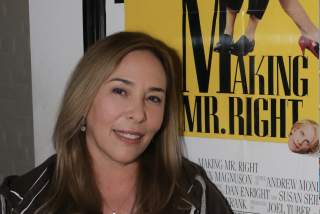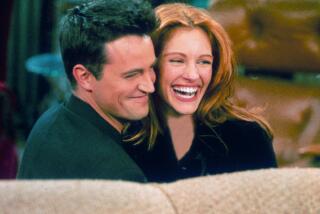MOVIE REVIEW : Movies: It’s Meryl Streep, not Roseanne Barr, whose comedy shines in director Susan Seidelman’s “She-Devil.”
In “She-Devil” (selected theaters), the feminine mystique meets its match. As Ruth, the dumpy malcontent whose accountant husband Bob (Ed Begley Jr.) leaves her for Mary Fisher (Meryl Streep), a famously frilly authoress of romance novels, Roseanne Barr swaggers into frame and wreaks ungodly revenge. Her mission has rabble-rousing mass appeal. She’s intended as a humongous stand-in for all the women who have ever been rejected in favor of someone younger, shapelier, fluffier.
In her TV series “Roseanne,” Barr’s roly-poly bulk isn’t played for vitriol and vengeance the way it is here. Beneath the wisecracking, she’s soft and sensual on that show, and her big teddy bear of a husband, played by John Goodman, is a perfect counterpart--his bluster is as transparent as hers.
In “She-Devil,” Barr’s stridency is unimpeded, and director Susan Seidelman encourages our identification with her solitary fury. But Seidelman also can’t resist scoring points against Ruth. She encourages our physical repulsion to the character, and so we’re continually subjected to immense, looming close-ups of Ruth jutting her pudgy face at us. (She has a large mole on her upper lip, and more than a hint of mustache.) Her unattractiveness may represent women’s worst fears of how their philandering husbands view them, but Seidelman appears to be in on the razzing. As feminist polemic, “She-Devil” is dubious indeed.
Are there two actresses further apart than Roseanne Barr and Meryl Streep? The high anticipation for this movie is largely based on their pairing. But, except for an early sequence where they first meet at a book party at the Guggenheim Museum--Ruth, in her floral print dress, accidentally spills wine on Mary Fisher--they hardly have a moment together.
The gloriously scabrous 1983 novel upon which the film is based, Fay Weldon’s “The Life and Loves of a She-Devil,” doesn’t allow for much interplay, either, and, in literary terms, the separateness works. (It also worked in the 1986 A&E;/BBC-TV miniseries of the novel.) Ruth’s guerrilla missions require her to be at a distance; they’re more fun that way, and more insidious.
But it’s a waste to have Barr and Streep in the same movie and then set them to shadow-boxing. We want to revel in the loony clash of opposite acting styles, but Seidelman and her screenwriters, Barry Strugatz and Mark R. Burns, haven’t shaped the material accordingly. A few fantasy confrontations might have helped, since the film, even at its most “realistic,” is such a hot-pink, high-camp fantasy anyway.
The funniest sequences in the movie take their cue from this camp floridness. Everything about Mary Fisher is flouncy and full of feminine filigree; she has created herself in the self-adoring image of her own romantic heroines. But, of course, it’s all just an elaborate act.
Thanks to Ruth, the fantasy bottoms out, and Ruth and Bob’s children, and Mary’s unwanted decrepit mother (Sylvia Miles), intrude on Mary’s seaside Long Island estate. Mary’s demureness snaps. Her fragile feathery voice begins to bark with annoyance. Meryl Streep may surprise audiences with her comic zing here, although she was funny in her brief, explosive scene as Lillian Hellman’s friend in “Julia,” and slyly hilarious, too, as the lawyer in “The Seduction of Joe Tynan.”
Streep is such a studied, meticulous actress that, at times, her performance here seems like an impersonation of funniness rather true funniness. But she’s so adroit that it’s tough to tell the difference. Playing high-style knockabout comedy comes naturally to Streep, or at least it comes naturally to her performer’s sense of craft. After such films as “A Cry in the Dark” and “Out of Africa,” her role in “She-Devil” may seem like a lark, but Streep goes at it with a ferocity that, in itself, is funny to watch.
“She-Devil” (rated PG-13 for strong language) is pitched deliberately shrill, in the manner of the TV shows and true-confession magazines it periodically parades before us. “Lifestyles of the Rich and Famous” makes an appearance here; so does People magazine and TV talk-show host Sally Jessy Raphael (as herself.)
Seidelman is trying to co-opt the trashiness of the pop media to both give her movie a charge and to indict the culture that elevates the false prettiness of the Mary Fishers of this world. But Seidelman’s sensibility is much more in line with Robin Leach’s than she realizes. That’s why Mary Fisher turns out rather well at the end. That’s why, when Ruth starts an employment agency for the “unloved and the unwanted,” the women who pass before us are viewed without sympathy as drab specimens.
Perhaps that’s why Ruth herself isn’t given much of a send-off. She discovers her self-esteem in the transforming powers of rage, and it feels like a hollow victory. If Ruth is meant to be some kind of new-style heroine, what does it say about her that we last see her defiantly alone in the crowd?
RELATED STORY: In View
More to Read
Only good movies
Get the Indie Focus newsletter, Mark Olsen's weekly guide to the world of cinema.
You may occasionally receive promotional content from the Los Angeles Times.










